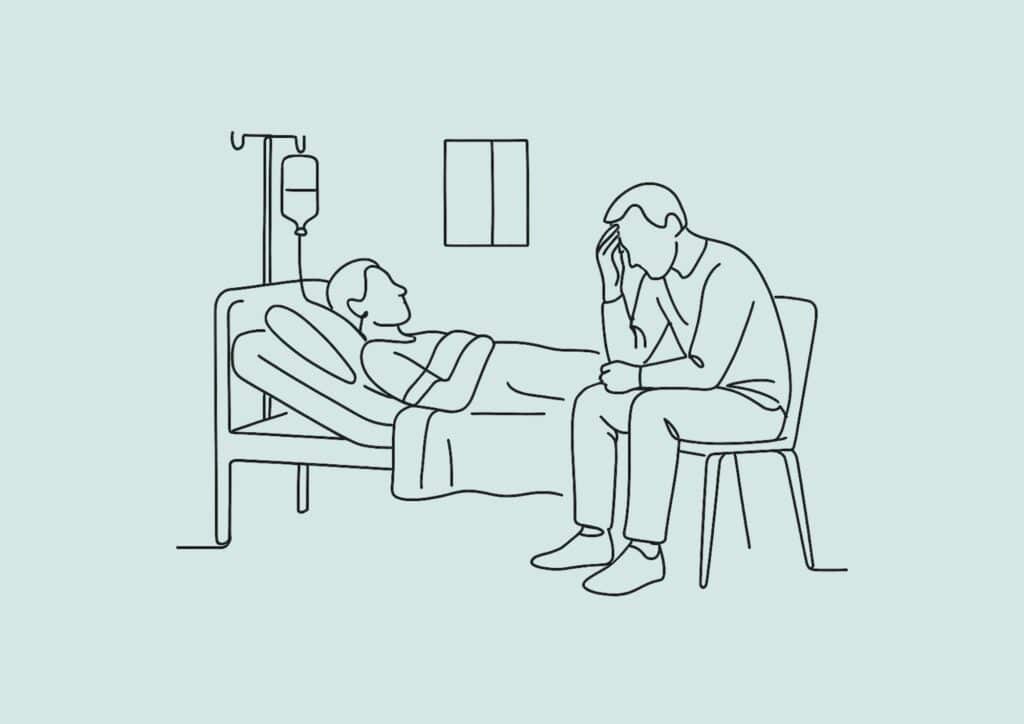For families in Ohio, Indiana, and Pennsylvania, understanding the cost of hospice care is a common concern when facing difficult healthcare decisions. The good news is that hospice services are widely covered by insurance, with most families experiencing little to no out-of-pocket expense. Knowing your coverage options can help you make informed choices about care without the stress of unexpected financial burdens.
The Foundation: Medicare Hospice Coverage
Medicare Part A provides the foundation for hospice coverage in the United States and serves as the model that most other insurance plans follow. Medicare hospice benefits are comprehensive and designed to remove financial barriers to end-of-life care.
What Medicare Covers at 100%
If you meet eligibility requirements, Medicare covers 100% of hospice services across Ohio, Indiana, and Pennsylvania. This comprehensive coverage includes:
Core medical services that form the foundation of hospice care are fully covered because Medicare recognizes that families shouldn’t face financial barriers during end-of-life care. According to Medicare guidelines, “If the patient has Medicare Part A and meets hospice eligibility requirements, then the government will pay as much as 100% of the cost of hospice care. In such a case, there is no deductible and no copayment for the patient.”
All necessary medications related to your hospice diagnosis are covered completely. This means families don’t need to worry about the cost of pain medications, anti-nausea drugs, or other comfort medications that are essential for quality of life. The coverage extends to both prescription medications and over-the-counter drugs when they’re part of the hospice care plan.
Durable medical equipment such as hospital beds, wheelchairs, oxygen equipment, and other necessary items are provided at no cost. This coverage ensures that patients have access to equipment that enhances comfort and safety in their home environment without requiring families to purchase or rent expensive medical equipment.
Hospice aide services that help with personal care, bathing, dressing, and light housekeeping are included in Medicare coverage. These services recognize that maintaining dignity and personal hygiene is essential to quality of life during hospice care.
Medicare Hospice Eligibility Requirements
To qualify for Medicare hospice benefits, patients must meet specific criteria:
- Medicare Part A enrollment is required, which most people receive automatically when they turn 65
- Physician certification that life expectancy is six months or less if the disease runs its normal course
- Choice to receive comfort care rather than curative treatments for the terminal diagnosis
- Care provided by a Medicare-certified hospice in your state, such as ViaQuest Hospice
Important note: You can change your mind at any time and return to curative treatments if you wish. The six-month prognosis requirement is an estimate, not a guarantee—if patients live longer than six months, they can continue receiving hospice care as long as they still meet the criteria.
Medicaid Hospice Coverage
Medicaid provides comprehensive hospice coverage in all states, following similar guidelines to Medicare. Coverage includes nursing care, medical social services, medications related to the hospice diagnosis, durable medical equipment, and bereavement support for families.
Medicaid hospice benefits mirror Medicare’s program and typically require providers to be both Medicare-certified and licensed by the state Department of Health. For families with limited financial resources, Medicaid coverage ensures that financial need doesn’t prevent access to quality end-of-life care.
State-specific details:
- Ohio Medicaid hospice services cover care in homes, nursing facilities, and inpatient hospice units
- Indiana Medicaid hospice coverage includes routine home care, inpatient care, respite care, and continuous care
- Pennsylvania Medicaid provides similar comprehensive coverage across all care settings
Note: Medicaid eligibility and specific covered services can vary by state, so families should contact their state Medicaid office or hospice provider for detailed information.
Private Insurance Coverage
Most private insurance plans provide hospice coverage that is comparable to or even more comprehensive than Medicare. The Employee Retirement Income Security Act (ERISA) requires most employer-sponsored health plans to include hospice benefits.
Understanding Your Private Insurance Benefits
Private insurance hospice coverage typically includes:
- Coverage levels: Many plans pay 100% for hospice services, similar to Medicare
- Eligibility requirements: Terminal illness diagnosis with life expectancy of six months or less, and election of palliative over curative care
- Covered services: Medical care, medications, equipment, respite care, and bereavement support
Important considerations:
- In-network vs. out-of-network status can significantly affect your costs
- Prior authorization requirements vary by insurance company
- Coverage periods may differ from Medicare’s indefinite coverage approach
Action step: Contact your insurance provider to verify coverage, confirm your hospice provider’s network status, and understand any required pre-authorizations before beginning care.
Veterans Affairs (VA) Benefits
Veterans may be eligible for hospice care through the Department of Veterans Affairs, which can provide either direct hospice services or coverage for care from community providers like ViaQuest Hospice.
VA Hospice Options
The VA offers multiple pathways for veterans to access hospice care:
VA medical centers may provide direct hospice care in some regions, offering specialized services that understand the unique needs of veterans and military families.
Community partnerships allow veterans to receive hospice care from certified community providers when VA facilities aren’t available or when patients prefer to remain in their local community. ViaQuest Hospice partners with the VA to serve veterans in our service areas.
Concurrent care may be available through the VA, potentially allowing veterans to receive both hospice care and some curative treatments that wouldn’t be covered simultaneously under traditional Medicare rules.
What’s Not Typically Covered
While hospice coverage is comprehensive, understanding the limitations can help families plan appropriately and avoid unexpected expenses.
Services Outside Hospice Scope
Certain services fall outside the scope of hospice care and may not be covered by hospice benefits:
Curative treatments for the terminal diagnosis are generally not covered once hospice care begins, since hospice focuses on comfort rather than cure. However, treatments for unrelated conditions can often continue.
Prescription medications unrelated to the hospice diagnosis may not be covered under hospice benefits, though they might be covered under other parts of your insurance plan.
Private duty nursing beyond what the hospice medical team determines is necessary may result in additional costs. The hospice team provides nursing visits based on medical need, but 24-hour private nursing isn’t typically covered.
Room and board costs for residential care facilities aren’t covered by hospice benefits, though the hospice medical services provided in these facilities are covered.
Financial Planning for Hospice Care
Even with comprehensive insurance coverage, families may want to plan for potential out-of-pocket expenses or explore additional financial assistance options.
Potential Out-of-Pocket Costs
Understanding what costs might arise can help families budget appropriately:
Respite care is covered by Medicare for up to five consecutive days at a time, but families might choose additional respite care that could result in costs.
Personal care items like special foods, comfort items, or non-medical supplies aren’t covered by hospice benefits but can be important for patient comfort.
Family accommodation costs when patients are receiving inpatient hospice care aren’t covered, though many hospice facilities try to accommodate family members.
Financial Assistance Programs
Several programs can help families manage hospice-related costs that aren’t covered by insurance:
Hospice foundation grants are available through many hospice organizations to help with uncovered expenses or emergency needs.
Pharmaceutical assistance programs from drug manufacturers can help with medications that aren’t covered under hospice benefits.
Local charitable organizations often provide assistance with medical expenses, transportation, or other needs for families facing serious illness.
Social work support through your hospice team can help identify and apply for financial assistance programs that might be available in your area.
Verifying Your Coverage
Before beginning hospice care, it’s important to verify your specific coverage to understand what will be covered and any potential out-of-pocket costs.
Steps to Verify Coverage
Taking these steps can help ensure smooth access to hospice care without financial surprises:
- Contact your insurance provider directly to confirm hospice benefits and any specific requirements your plan might have
- Check network status for your preferred hospice provider
- Understand authorization requirements so you know whether prior approval is needed and how to obtain it
- Review your plan documents to understand any benefit limitations, such as coverage periods or specific service restrictions
Tip: Most hospice providers, including ViaQuest Hospice, have insurance specialists who can help navigate insurance verification and enrollment processes.
How ViaQuest Hospice Supports Coverage Navigation
Understanding insurance coverage can be complex, especially during an emotionally difficult time. ViaQuest Hospice provides dedicated support to help families navigate their coverage options and access care without financial barriers.
Our insurance specialists work directly with families to verify benefits, obtain necessary authorizations, and handle billing processes so families can focus on what matters most—spending quality time together. We accept Medicare, Medicaid, and most private insurance plans, and we’re committed to ensuring that cost never becomes a barrier to receiving compassionate hospice care.
The goal of comprehensive hospice coverage is to remove financial stress during an already difficult time, allowing families to focus on comfort, dignity, and making meaningful memories together.
Making Informed Decisions
Understanding your hospice insurance coverage empowers you to make informed decisions about care options without worrying about unexpected costs. The comprehensive nature of hospice coverage reflects society’s recognition that end-of-life care should be accessible to everyone, regardless of financial circumstances.
When families understand that hospice care is typically fully covered, they can make decisions based on medical need and quality of life considerations rather than financial concerns. This understanding often leads to earlier hospice enrollment, which research shows can improve both quality of life and, in some cases, even longevity.
ViaQuest Hospice accepts Medicare, Medicaid, and most private insurance plans. Our insurance specialists work directly with families to verify benefits, obtain necessary authorizations, and handle billing processes so families can focus on what matters most—spending quality time together.
Ready to understand your specific hospice coverage options? Download our comprehensive Hospice Care Guide, which includes detailed information about insurance coverage, what to expect from hospice services, and how to navigate the enrollment process. This resource helps families understand their options and make informed decisions about care.
[Download Free Hospice Care Guide]
For personalized assistance with insurance verification and understanding your coverage options, call ViaQuest Hospice at (855) 289-1722. Our insurance specialists can help verify your benefits and explain how hospice coverage works with your specific insurance plan, ensuring you have all the information needed to make the best decisions for your family.






